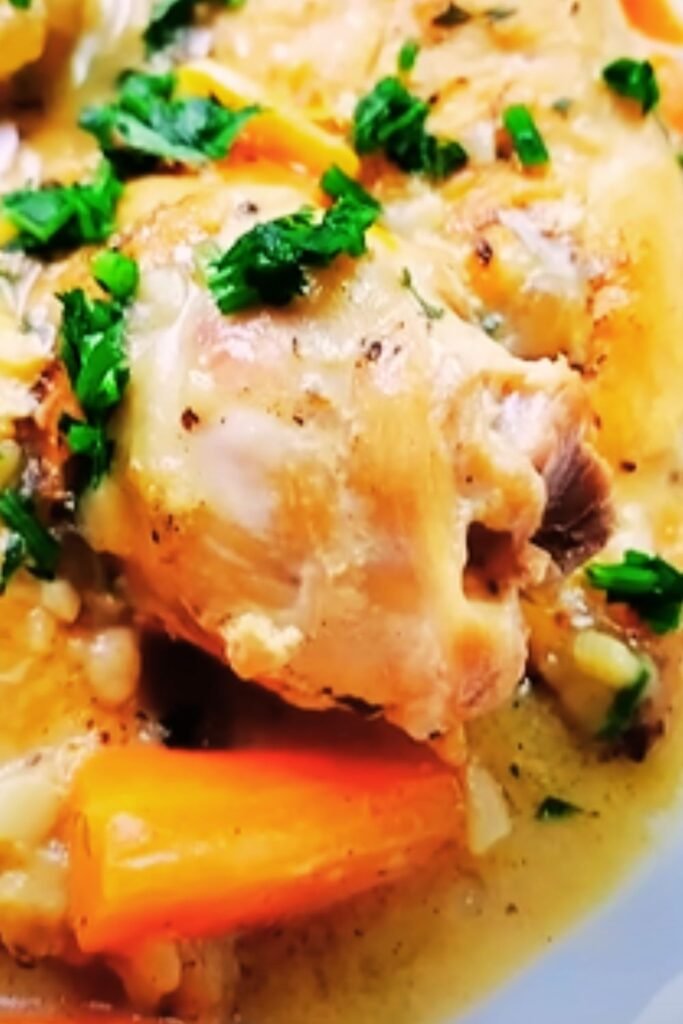There’s something deeply comforting about a chicken casserole that has been slowly simmering away, filling your kitchen with mouthwatering aromas. Among the many chicken casseroles I’ve prepared over the years, the French Chicken Casserole à la Normande stands out as one of the most sophisticated yet surprisingly simple dishes to master. This classic from the Normandy region of France combines tender chicken with apples and cream to create a dish that’s both rustic and elegant.
As someone who has traveled extensively through Normandy, I’ve had the pleasure of enjoying this dish in its homeland, where it’s often served in cozy countryside restaurants. The region is famous for its apples, dairy, and poultry—all of which come together beautifully in this traditional casserole.
Today, I’m sharing my perfected recipe for French Chicken Casserole à la Normande, along with tips I’ve gathered from French home cooks and professional chefs alike. Whether you’re cooking for a special occasion or simply want to elevate your weeknight dinner, this dish is sure to impress.
The Story Behind Chicken à la Normande
Normandy, with its lush green pastures and abundant apple orchards, has a culinary tradition deeply rooted in its local produce. The region’s cuisine is characterized by the liberal use of cream, butter, and apples—often in combination with seafood or poultry.
The “à la Normande” cooking style typically refers to dishes prepared with apples, cream, and sometimes calvados (apple brandy). This cooking method dates back centuries and emerged as a way to showcase the region’s finest ingredients. Farm families would prepare these hearty one-pot meals using whatever was available from their land.
What makes this casserole so special is the perfect balance of flavors—the slight tartness of the apples cuts through the richness of the cream sauce, while the chicken absorbs all these wonderful flavors as it cooks to tender perfection.
Essential Ingredients
To create an authentic Chicken à la Normande, you’ll need high-quality ingredients that honor the dish’s Norman roots:
- Chicken pieces: Traditional recipes use a whole chicken cut into pieces, but you can simplify by using bone-in, skin-on thighs and breasts
- Apples: Firm varieties like Braeburn or Granny Smith hold their shape during cooking
- Calvados or Apple Brandy: For that signature Norman flavor
- Heavy cream: Fresh and full-fat creates the richest sauce
- Mushrooms: Button or cremini add earthy depth
- Aromatics: Onions, garlic, and herbs build the flavor base
- Butter: French cooking relies on good butter, unsalted is best
- Chicken broth: Homemade is ideal but a good quality store-bought works too
Equipment You’ll Need
The right equipment makes preparing this casserole much easier:
- Large Dutch oven or heavy-bottomed casserole dish
- Sharp chef’s knife for cutting chicken and vegetables
- Wooden spoon for sautéing and stirring
- Tongs for handling chicken pieces
- Measuring cups and spoons
- Small bowl for mixing cream and flour
- Cutting board (separate ones for chicken and produce)
The Complete Recipe
French Chicken Casserole à la Normande
Prep Time: 30 minutes
Cook Time: 1 hour 15 minutes
Total Time: 1 hour 45 minutes
Servings: 6
Ingredients:
- 1 whole chicken (about 4-5 pounds), cut into 8 pieces (or 4 bone-in chicken breasts and 4 thighs)
- 3 tablespoons unsalted butter, divided
- 2 tablespoons olive oil
- 2 medium onions, finely chopped
- 3 garlic cloves, minced
- 8 ounces mushrooms, sliced
- 3 tablespoons all-purpose flour
- 1 cup chicken broth
- ½ cup Calvados or apple brandy (can substitute with apple cider for non-alcoholic version)
- 2 firm apples (Braeburn or Granny Smith), peeled, cored, and cut into ½-inch slices
- 1 cup heavy cream
- 3 sprigs fresh thyme
- 2 bay leaves
- Salt and freshly ground black pepper
- 3 tablespoons fresh parsley, chopped
- 1 tablespoon fresh tarragon, chopped (optional)
Instructions:
- Prepare the chicken: Pat the chicken pieces dry with paper towels and season generously with salt and pepper on both sides.
- Brown the chicken: Heat 1 tablespoon butter and the olive oil in a large Dutch oven over medium-high heat. Working in batches to avoid overcrowding, brown the chicken pieces on all sides, about 4-5 minutes per side. Transfer the browned chicken to a plate and set aside.
- Create the flavor base: In the same pot, reduce heat to medium and add another tablespoon of butter. Add the chopped onions and cook until softened and translucent, about 5 minutes. Add the garlic and cook for another minute until fragrant.
- Add mushrooms: Add the sliced mushrooms and cook until they release their moisture and begin to brown, about 8-10 minutes.
- Make the sauce base: Sprinkle the flour over the vegetables and stir constantly for 2 minutes to cook the flour. Slowly pour in the chicken broth, stirring continuously to prevent lumps from forming.
- Deglaze with Calvados: Pour in the Calvados or apple brandy, scraping the bottom of the pot to release any browned bits. Bring to a simmer and let the liquid reduce by half, about 5 minutes.
- Return chicken to pot: Return the chicken pieces to the pot, along with any accumulated juices. Add the thyme sprigs and bay leaves. Bring to a simmer, then reduce heat to low. Cover and cook for 30 minutes.
- Prepare the apples: While the chicken is simmering, heat the remaining tablespoon of butter in a separate skillet over medium heat. Add the apple slices and cook until lightly browned but still firm, about 3-4 minutes per side. Remove from heat and set aside.
- Finish the casserole: After the chicken has cooked for 30 minutes, add the sautéed apples to the pot. In a small bowl, whisk together the heavy cream with 3 tablespoons of the hot liquid from the pot. Slowly pour this mixture into the pot, stirring gently to incorporate.
- Final cooking: Cover and simmer for an additional 15-20 minutes, until the chicken is very tender and cooked through (internal temperature should reach 165°F/74°C).
- Adjust seasoning: Remove the thyme sprigs and bay leaves. Taste the sauce and adjust seasoning with salt and pepper as needed.
- Garnish and serve: Sprinkle with chopped fresh parsley and tarragon if using. Serve hot.

Pro Tips for the Perfect Chicken à la Normande
Through years of making this dish, I’ve discovered several techniques that elevate it from good to exceptional:
- Don’t rush the browning process: Properly browned chicken creates a deeper flavor base. Take your time with this step.
- Choose the right apples: Firm, slightly tart apples hold their shape better during cooking and provide a nice contrast to the rich sauce.
- Homemade stock makes a difference: If you have time, make your own chicken stock for a more intense flavor.
- Balance the cream: If you find the sauce too rich, a squeeze of lemon juice just before serving can brighten all the flavors.
- Rest before serving: Allow the casserole to rest for 10 minutes off the heat before serving—this helps the flavors meld and the sauce to slightly thicken.
- Control the heat: Keep the simmer gentle to prevent the cream from curdling.
- Quality matters: With relatively few ingredients, each one should be the best quality you can find, especially the cream and butter.
Common Mistakes to Avoid
Even experienced cooks can run into problems with this dish. Here are some pitfalls to watch out for:
- Overcrowding the pan when browning chicken, which causes steaming instead of browning
- Adding cold cream directly to the hot liquid, which may cause it to curdle (always temper it first)
- Using boneless, skinless chicken, which won’t provide the same rich flavor and can dry out
- Overcooking the apples until they turn mushy
- Skipping the flour, which helps stabilize the cream sauce
- Adding too much liquid, resulting in a thin sauce (it should coat the back of a spoon)
Variations on the Classic
While I’m a purist when it comes to traditional recipes, there are several acceptable variations to this classic dish:
Cider Substitution
Replace the Calvados with dry apple cider for a milder flavor that’s still authentically Norman.
Herb Variations
Tarragon is my herb of choice for this dish, but you could also use sage or rosemary for different aromatic profiles.
Vegetable Additions
For a more substantial one-pot meal, add carrots, celery, or leeks when sautéing the onions.
Lighter Version
For those watching calories, you can substitute half-and-half for the heavy cream, though the sauce won’t be quite as luxurious.
Serving Suggestions
A dish this special deserves to be served with carefully chosen accompaniments:
- Crusty French baguette for soaking up the delicious sauce
- Steamed green beans or haricots verts with a squeeze of lemon
- Buttery mashed potatoes or creamy polenta
- Simple green salad with a light vinaigrette
- Roasted root vegetables in cooler months

Make-Ahead and Storage Tips
One of the virtues of this casserole is that it actually improves with time as the flavors continue to develop.
Make-Ahead Options:
You can prepare this casserole up to 2 days ahead of time. In fact, I often find the flavor is even better on the second day. Simply reheat gently on the stovetop over medium-low heat until thoroughly warmed.
Storage Guidelines:
- Refrigerator: Store leftovers in an airtight container for up to 3 days.
- Freezer: This dish freezes reasonably well for up to 2 months, though the texture of the cream sauce may change slightly upon thawing. Defrost overnight in the refrigerator before reheating.
- Reheating: Always reheat cream-based dishes gently to prevent the sauce from breaking. Add a splash of chicken broth if the sauce has thickened too much during storage.
Nutritional Information
For those who are mindful of their nutritional intake, here’s a breakdown of what you can expect per serving of this chicken casserole:
| Nutrient | Amount per Serving |
|---|---|
| Calories | 520 |
| Protein | 38g |
| Carbohydrates | 12g |
| Fat | 34g |
| Saturated Fat | 18g |
| Fiber | 2g |
| Sugar | 6g |
| Sodium | 480mg |
| Calcium | 8% DV |
| Iron | 15% DV |
| Vitamin A | 20% DV |
| Vitamin C | 12% DV |
Note: Nutritional values are approximate and may vary based on specific ingredients used.
Historical Context: The Calvados Connection
The use of Calvados in Norman cuisine dates back centuries. This apple brandy, produced exclusively in Normandy, adds a distinctive flavor that’s integral to many traditional dishes from the region.
During the 17th century, distillation techniques improved significantly in Normandy, leading to higher quality Calvados. By the 19th century, it had become a staple ingredient in Norman cooking, particularly in recipes featuring apples, cream, and poultry or pork.
Traditionally, farmers would take a “trou Normand” (Norman hole)—a small glass of Calvados—between courses during lengthy meals to stimulate the appetite. This practice reflects the deep cultural significance of apple spirits in Norman gastronomy.
In this casserole, the Calvados serves multiple purposes: it deglazes the pan, capturing all the flavorful browned bits; it infuses the dish with apple essence; and it adds complexity that balances the richness of the cream.

Why This Recipe Works
As someone who has made this dish countless times, I’ve come to understand exactly why certain elements are essential:
- The combination of butter and oil for browning provides higher heat tolerance while still imparting butter flavor.
- Bone-in, skin-on chicken pieces release more flavor into the sauce and stay moister during the long cooking process.
- The flour roux stabilizes the cream sauce, preventing it from separating during cooking.
- Sautéing the apples separately ensures they maintain their integrity instead of disintegrating into the sauce.
- Tempering the cream by mixing it with some of the hot cooking liquid prevents curdling when added to the pot.
- The gentle simmer allows all the flavors to meld without toughening the chicken.
- The acid from the apples cuts through the richness of the cream, creating a perfectly balanced sauce.
Frequently Asked Questions
Over the years, I’ve received many questions about this recipe. Here are the most common ones with my detailed answers:
Can I use boneless, skinless chicken breasts instead? While you can, I don’t recommend it. Boneless breasts cook much faster and tend to dry out during the long simmering time this recipe requires. If you must use them, reduce the cooking time significantly and monitor closely for doneness.
What can I substitute for Calvados if I don’t have it? Apple brandy or apple jack makes the best substitution. For an alcohol-free version, use apple cider reduced by half to concentrate the flavor, plus a splash of apple cider vinegar for complexity.
My cream sauce curdled. What went wrong? This typically happens when the heat is too high or when cold cream is added directly to a very hot liquid. Always temper your cream by mixing it with some of the hot cooking liquid before adding it to the pot, and keep your simmer gentle.
Can I make this dish in a slow cooker? Yes, but you’ll still need to brown the chicken and sauté the vegetables on the stovetop first. Transfer everything to the slow cooker and cook on low for 4-5 hours. Add the cream during the last 30 minutes of cooking.
How do I know when the chicken is done? The most reliable method is using an instant-read thermometer—chicken should reach 165°F (74°C) at the thickest part. Alternatively, the meat should easily pull away from the bone, and the juices should run clear when pierced.
Why are my apples turning mushy? This can happen if you’re using a soft apple variety or if they’re overcooked. Stick with firm varieties like Granny Smith or Braeburn, and don’t add them until the later stages of cooking.
Can this be made dairy-free? While not traditional, you could substitute coconut cream for the heavy cream. The flavor profile will change significantly, but it can still be delicious in its own right.
Final Thoughts
French Chicken Casserole à la Normande represents the very best of French country cooking—simple ingredients transformed into something extraordinary through careful technique and an understanding of flavor balance. This dish has become one of my signature recipes, requested frequently by friends and family for special gatherings.
What I love most about this casserole is how it brings a taste of Normandy’s apple orchards and dairy farms to my dinner table, no matter where I am. It’s comfort food elevated to an art form, yet accessible enough for home cooks to master.
The next time you’re looking to impress dinner guests or simply want to treat yourself to something special, I hope you’ll try this recipe. Pour a glass of dry French cider alongside it, and for a moment, you might just feel transported to a charming Norman farmhouse, with apple trees dotting the landscape outside the window.
Remember, cooking is about more than following instructions—it’s about understanding the soul of a dish and the culture it comes from. This chicken casserole captures the essence of Norman cuisine in every bite: honest, rich, and perfectly balanced.


